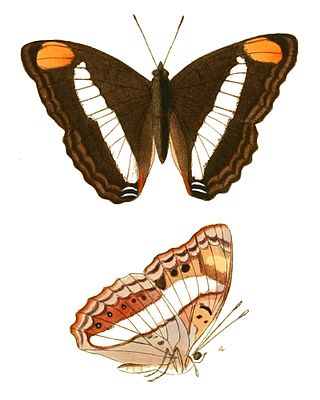An emperor is a type of monarch.

Celtis is a genus of about 60–70 species of deciduous trees, commonly known as hackberries or nettle trees, in the hemp family Cannabaceae. It has a cosmopolitan distribution.
Hackberries is a common name for
An empress is a female imperial monarch, or the wife of an imperial monarch; written with a capital, Empress is used as the title of an empress, placed before her name – often just the given name.

The hymenopteran family Scelionidae is a very large cosmopolitan group of exclusively parasitoid wasps, mostly small (0.5–10 mm), often black, often highly sculptured, with (typically) elbowed antennae that have a 9- or 10-segmented flagellum. It was once considered to be a subfamily of the Platygastridae, but has been revived in the most recent classification of Platygastroidea.

Asterocampa clyton, the tawny emperor, is a species of brush-footed butterfly. It is native to North America, especially the eastern half from Canada to northern Mexico. The tawny emperor should not be mistaken for a very similar Asterocampa butterfly, the hackberry emperor, which can be distinguished by the white spots near the tip of its forewing and the black eyespot lower along the edge of the forewing.

Asterocampa celtis, the hackberry emperor, is a North American butterfly that belongs to the brushfooted butterfly family, Nymphalidae. It gets its name from the hackberry tree upon which it lays its eggs. The hackberry tree is the only host plant for A. celtis and is the food source for larvae.
Tawny emperor is the common name of two species of brush-footed butterflies in the subfamily Apaturinae:

Asterocampa leilia, the Empress Leilia, Leilia hackberry butterfly or desert hackberry, is a species of butterfly in the family Nymphalidae.

Doxocopa pavon, the Pavon emperor or Pavon, is a species of butterfly in the family Nymphalidae. They can be found from Paraguay in South America up to Texas in the southern United States. They are generally brown in their overall coloration, with two bands of white straddling the middle of the upper surfaces of the wings, and a patch of orange on the tips of their forewings. The upper surfaces of the wings of the males are overlaid by an iridescent blue-purple sheen. The females of the species closely resemble members of the unrelated genus Adelpha.
Desert hackberry may refer to:

Scelioninae is a subfamily of wasps in the family Scelionidae. It is a very large cosmopolitan group of exclusively parasitoid wasps, mostly small (0.5–10 mm), often black, often highly sculptured, usually with geniculate (elbowed) antennae that have a 9- or 10-segmented flagellum. It was formerly classified as a subfamily of the Platygastridae, but in 2021 the family Scelionidae was revived, containing the subfamilies Scelioninae, Teleasinae, and Telenominae.
This page is based on this
Wikipedia article Text is available under the
CC BY-SA 4.0 license; additional terms may apply.
Images, videos and audio are available under their respective licenses.







